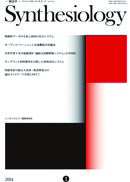Volume 7, Issue 1
Displaying 1-8 of 8 articles from this issue
- |<
- <
- 1
- >
- >|
Research papers
-
2014 Volume 7 Issue 1 Pages 1-15
Published: 2014
Released on J-STAGE: June 11, 2014
Download PDF (8818K) -
2014 Volume 7 Issue 1 Pages 16-26
Published: 2014
Released on J-STAGE: June 11, 2014
Download PDF (2119K) -
2014 Volume 7 Issue 1 Pages 27-35
Published: 2014
Released on J-STAGE: June 11, 2014
Download PDF (5995K) -
2014 Volume 7 Issue 1 Pages 36-42
Published: 2014
Released on J-STAGE: June 11, 2014
Download PDF (4521K) -
2014 Volume 7 Issue 1 Pages 43-56
Published: 2014
Released on J-STAGE: June 11, 2014
Download PDF (6200K)
Editorial board
-
2014 Volume 7 Issue 1 Pages 57-58
Published: 2014
Released on J-STAGE: June 11, 2014
Download PDF (295K) -
2014 Volume 7 Issue 1 Pages 59-60
Published: 2014
Released on J-STAGE: June 11, 2014
Download PDF (267K)
Letter from the editor
-
2014 Volume 7 Issue 1 Pages 67
Published: 2014
Released on J-STAGE: June 11, 2014
Download PDF (389K)
- |<
- <
- 1
- >
- >|
